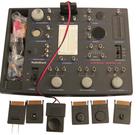In recent years, sensors are in the stage of transition from traditional to new sensors. The new sensors are characterized by miniaturization, digitization, intelligence, multi-functionalization, systematization, and networking. They not only promote the transformation of traditional industries, but also lead to the establishment of new industries. They are the new economic growth points in the 21st century. Miniaturization is based on Micro-Electro-Mechanical System (MEMS) technology and has been successfully applied to form silicon pressure sensors (such as the EJX transmitter mentioned above) on silicon devices. Microelectronic machining technologies include bulk micromachining technology, surface micromachining technology, LIGA technology (X-ray deep lithography, microelectroforming and microreplication technology), laser micromachining technology, and micro-encapsulation technology. The development of MEMS has raised the level of miniaturization, intelligence, multi-functionality and reliability of sensors to a new level. Sensor detection instrument, based on microelectronic technology, built-in microprocessor, or micro-sensor and microprocessor and related integrated circuits (operational amplifier, A/D or D/A, memory, network communication interface circuit) Such as packaged together to complete the digital, intelligent, networked, systematic. (Note: MEMS technology also completes products such as micro-motors or actuators, and will be described in another article.) In terms of networking, currently it mainly refers to the use of multiple fieldbuses and Ethernet (Internet), which should be selected according to the characteristics of each industry. Among them one or more, in recent years the most popular are FF, Profibus, CAN, Lonworks, AS-Interbus, TCP/IP and so on. In addition to MEMS, the development of new sensors also depends on new sensitive materials, sensitive components and nanotechnology, such as a new generation of fiber optic sensors, superconducting sensors, focal plane display infrared detectors, biosensors, nanosensors, new quantum sensors, micro-gyro , networked sensors, smart sensors, fuzzy sensors, multi-sensors, etc. Multi-sensor data fusion technology is forming hot spots. It was formed in the 1980s. It differs from general signal processing and also differs from single or multiple sensor monitoring and measurement. It is based on measurement results based on multiple sensors. High-level integrated decision-making process. In view of the miniaturization and intelligentization of sensor technology, based on the information acquisition, multiple functions are further integrated, resulting in an inevitable trend. Multi-sensor data fusion technology also promotes the development of sensor technology. The definition of multi-sensor data fusion is summarized: the local data resources provided by multiple sensors of the same type or different types distributed in different positions are integrated and analyzed by computer technology to eliminate possible redundancy between multi-sensor information and Contradictions are complemented to reduce uncertainty, and a consistent interpretation and description of the measured objects is obtained, thereby improving the speed and correctness of the system's decision-making, planning, and response so that the system can obtain fuller information. Its information fusion appears at different levels of information, including data layer (pixel layer) fusion, feature layer fusion, decision layer (evidence layer) fusion. Because it has the following advantages over single sensor information, that is, fault tolerance, complementarity, real-time, and economy, it has been gradually applied. In addition to military applications, the application field has been applied to automation technology, robotics, marine surveillance, seismic observation, construction, air traffic control, medical diagnosis, and remote sensing technology. China's sensor industry must adapt to the trend of technology and develop both internationally and domestically, and let the sensors and detection instruments seize the opportunity of informationization. Matting Agent For Industrial Coatings
Description
1,
Silica Matting Agent reduce the gloss of a variety of products including
coatings, paints, inks, lacquers, varnishes, while providing lower viscosity
and better flow capability. It is synthetic amorphous silica
appearing as white powder. It is a micronized precipitated silica matting agent
for both solvent-based and water-based system. These efficient matting agent
are suitable for unpigmented and pigmented systems. Careful design and control
of silica physical properties ensure dispersion
stability, hand-feel, anti-setting behavior and scratch resistance in
solvent-borne and water-borne system.
2, Matting
Agent
specialized used for the Industrial coatings. It provided high matting
efficiency, excellent coating appearance and high transparency. As well as low
oil absorption, easy dispersion and smoothly touch with minimal impact of
viscosity.
Feature
1) High Matting
Efficiency: High pore volume reaches to 1.8-2.0 ml/g, and fine
control of the particle size and particle size distribution.
2) Easy to Dispersion: The matting agent
can be easily added in any production procedure and can be easily dispersed, which
saves the processing time.
3)Good handing feeling and improvement in
scratch resistance: It is development of smooth films with excellent hand-feel,
scratch resistance and stain resistance.
Application
1, Industrial
Coating, Metal baking Coating, Decorative Coating
2, Printing
Inks, Gravure Printing Ink, Offset Printing Ink, Screen Printing Ink,
Printing Packing Material.
3, Automotive
Coating, Car Coating.
4, Plastic
Coating, 3C Coating.
5, Clear and
pigmented woodcare applications, such as NC wood coatings, PU wood coatings,
unsaturated polyester wood coatings.
Strengths
1) We focus on silica matting agent market
about 25 years. Know exactly the customer`s requirements, have most experience
about this silica products, provide the best service to the customers.
2) We are the reliable supplier for many
countries and some International customers, such as AkzoNobel, Valspar, Nippon
Paints, Dgl Camel, and PPG.
Matting Agent For Industrial Coating,Decorative Coatings Silica,Carbon Black Silica Dioxide,Silica Dioxide Paint Matting Agent Guangzhou Quanxu Technology Co Ltd , https://www.inkjetcoating.com